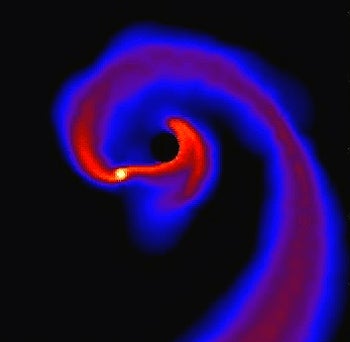What happens when a neutron star edges too close to a black hole? Recent studies applying relativistic instead of Newtonian rules show that, under most circumstances, neutron stars plunge directly into black holes without forming an accretion disk. These new findings will help astronomers trying to understand gamma-ray bursts (GRBs) and listening for gravitational-wave signals from such events.
M. Coleman Miller, an astrophysicist at the University of Maryland, has now tracked neutron star-black hole tangos under relativistic rules, with strikingly different results. He built on recent work by theorists Alessandra Buonanno (University of Paris), Stuart Shapiro (University of Illinois at Urbana-Champaign), and Fred Rasio at Northwestern University, among others. The study will appear in The Astrophysical Journal Letters.
Miller tells Astronomy that in Einstein’s rubbery space-time, rather than forming accretion disks and orbiting black holes for extended periods, neutron stars plunge “promptly” into black holes.
How promptly? According to Miller, once a neutron star ventures closer than 3 times the radius of a non-spinning black hole, it will vanish within a millisecond.
“When black holes eat neutron stars, they do it like snakes,” Miller says. “They swallow the neutron stars whole.”
In the relativistic space-time around a black hole, Miller finds, neutron stars rapidly lose angular momentum, which ripples away as gravitational waves. “Even a small loss of angular momentum will lead to a rapid plunge,” he says, so black holes gulp down neutron stars under almost all circumstances, even when the black hole is spinning rapidly in the same direction as the neutron star’s orbit.
Miller doesn’t know what happens around a black hole spinning as fast as it can. That would require extremely difficult “full general relativistic numerical calculations with no approximations.” Still, he concludes, “It appears possible that no plausible combination of neutron star and black hole masses, spins, and orbital inclinations will result in an accretion disk or stable mass transfer.”
Rasio finds the relativistic results far more realistic. “For the first time ever, this paper gives, in my opinion, a correct description of the final fate of these mergers. This would imply no gamma-ray burst from such a merger, in contrast to many previous speculations.”
The gravitational-wave signal would also be different, Rasio tells Astronomy. “The inspiral [chirp] signal would simply end without any dramatic signature corresponding to the final merger.”










